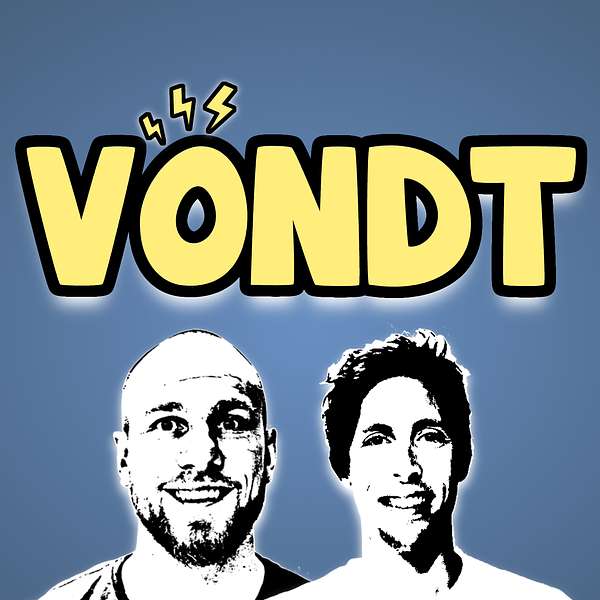
VONDT - en podcast om muskel- og skjelettplager
Dette er podcasten der vi vil samle alle faggrupper og profesjoner som jobber med det som årlig i Norge plager flest og koster mest - nemlig muskel- og skjelettplager. Vi vil skape gode samtaler og diskusjoner rundt ulike tema som daglig berører oss i vår kliniske praksis, også med hjelp av gjester med særlig kompetanse på ulike fagområder. Gi oss gjerne innspill til tema eller gjester og veldig gjerne tilbakemeldinger på innholdet, både på godt og vondt, så er du med å utvikle denne podcasten til en viktig kilde til faglig oppdatering for så mange som mulig.
VONDT - en podcast om muskel- og skjelettplager
EP 3: Trening med mening
"Min medisin er fysisk aktivitet!". Dette slagordet stod på t-skjortene våre gjennom studietiden på fysioterapiutdanningen, og i lys av den kunnskapsmengden vi har i dag er det et slagord vi bør bære med stolthet. MEN; hvor godt kjenner vi den medisinen vi skriver ut? Hvor godt virker den, egentlig? Hvordan virker den? Hvordan øker vi sannsynligheten for at pasientene våre faktisk tar den?
I tillegg til å utdype spørsmålene over er "Trening med mening" episoden der vi spør oss; "Hva er meningen? Og, hvor finner vi den?".
Referanser:
Babatunde, O.O., et al.: Effective treatment options for musculoskeletal pain in primary care: A systematic overview of current evidence. PLoS One, 2017. 12(6): p. e0178621.
Bialosky, J.E., et al.: Individual expectation: an overlooked, but pertinent, factor in the treatment of individuals experiencing musculoskeletal pain.Phys Ther, 2010. 90(9): p. 1345-55.
Chester, R., et al.: Psychological factors are associated with the outcome of physiotherapy for people with shoulder pain: a multicentre longitudinal cohort study. Br J Sports Med, 2016.
Cook, J.L., et al.: "Rehabilitation will increase the 'capacity' of your ...insert musculoskeletal tissue here...." Defining 'tissue capacity': a core concept for clinicians. Br J Sports Med, 2015. 49(23): p. 1484-5.
Gabbett, T.J., et al.: High training workloads alone do not cause sports injuries: how you get there is the real issue. Br J Sports Med, 2016. 50(8): p. 444-5.
Glasgow, P., et al.: Optimal loading: key variables and mechanisms. Br J Sports Med, 2015. 49(5): p. 278-9.
Hoffmann, T.C., et al.: Patients' Expectations of the Benefits and Harms of Treatments, Screening, and Tests: A Systematic Review. JAMA Intern Med, 2014.
Medina-Mirapeix, F., et al.: Predictive factors of adherence to frequency and duration components in home exercise programs for neck and low back pain: an observational study. BMC Musculoskelet Disord, 2009. 10: p. 155.
Picha, K.J., et al.: A model to increase rehabilitation adherence to home exercise programmes in patients with varying levels of self-efficacy.Musculoskeletal Care, 2017.
Pihl, K., et al.: Over-optimistic patient expectations of recovery and leisure activities after arthroscopic meniscus surgery. Acta Orthop, 2016: p. 1-7.
Rio, E., et al.: Isometric exercise induces analgesia and reduces inhibition in patellar tendinopathy. Br J Sports Med, 2015. 49(19): p. 1277-83.
Rossettini, G., et al.: Clinical relevance of contextual factors as triggers of placebo and nocebo effects in musculoskeletal pain. BMC Musculoskelet Disord, 2018. 19(1): p. 27.
Smith, B.E., et al.: Should exercises be painful in the management of chronic musculoskeletal pain? A systematic review and meta-analysis. Br J Sports Med, 2017.
Smith, B. E., et al.: Musculoskeletal pain and exercise—challenging existing paradigms and introducing new. British Journal of Sports Medicine. 2019
Testa, M., et al.: Enhance placebo, avoid nocebo: How contextual factors affect physiotherapy outcomes. Man Ther, 2016. 24: p. 65-74.
Wroblewski, A.P., et al.: Chronic exercise preserves lean muscle mass in masters athletes. Phys Sportsmed, 2011. 39(3): p. 172-8.
Zou, K., et al.: Examination of overall treatment effect and the proportion attributable to contextual effect in osteoarthritis: meta-analysis of randomised controlled trials. Ann Rheum Dis, 2016. 75(11): p. 1964-1970.
MUSIKK:
Joseph McDade-Mirrors